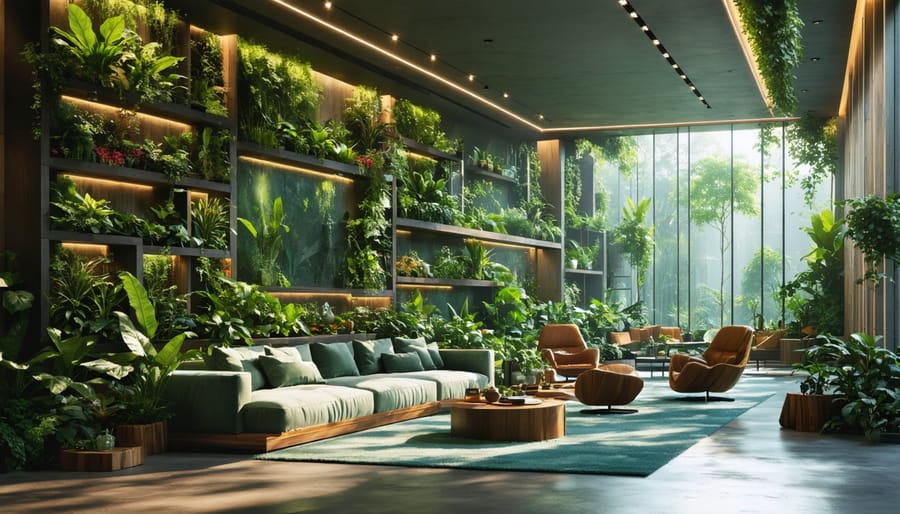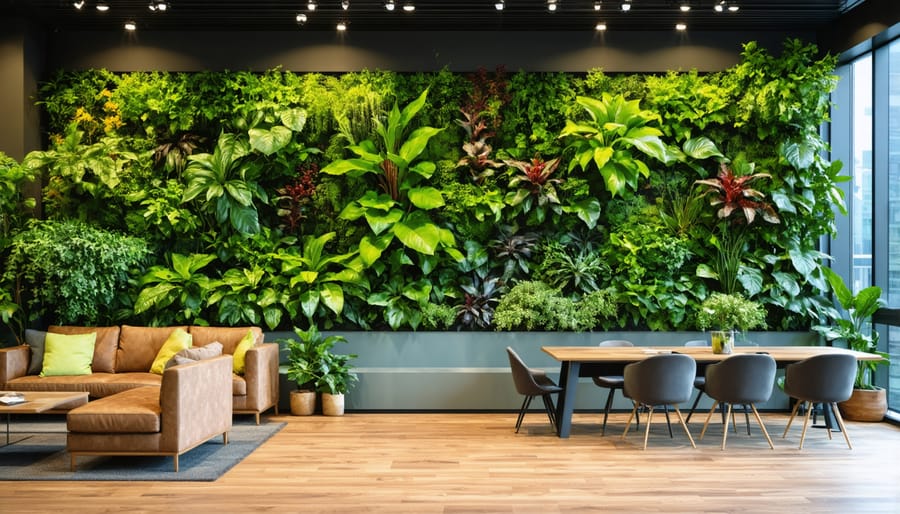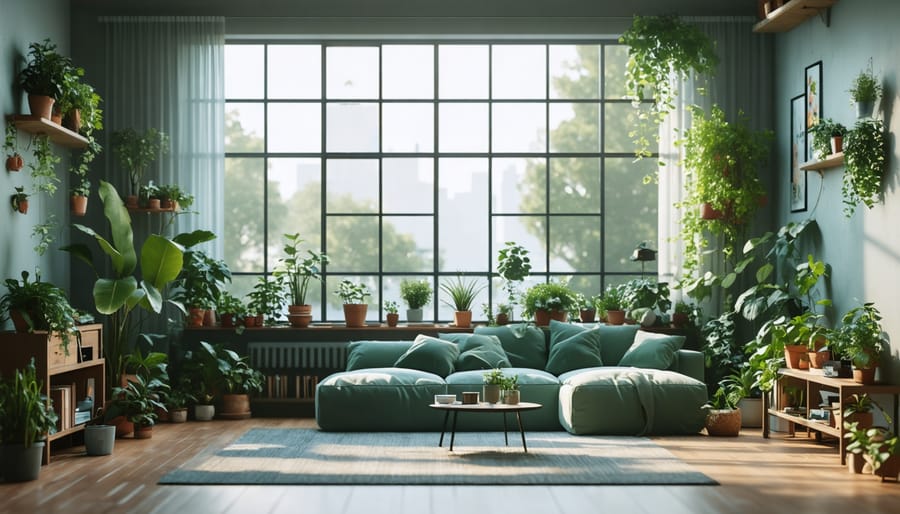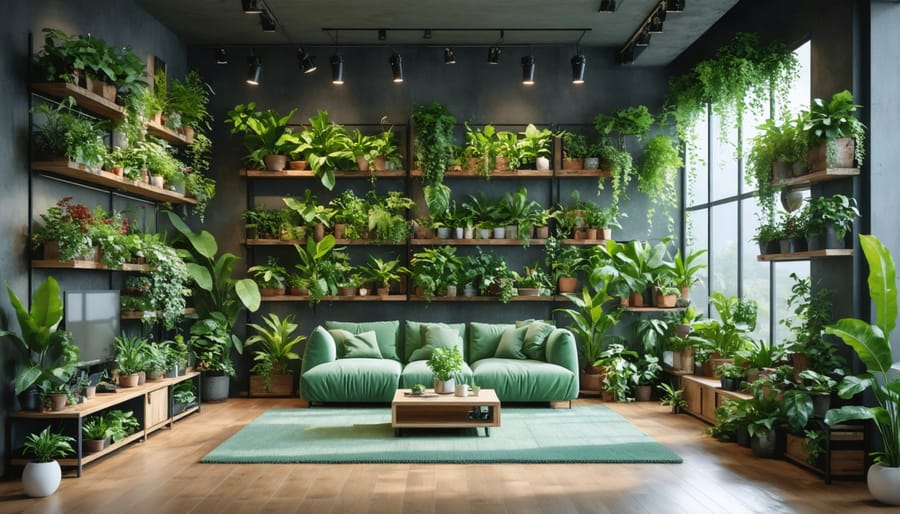
Transform your living spaces into vibrant, wellness-promoting environments through biophilic design – the revolutionary approach that connects modern interiors with nature’s inherent beauty and restorative power. As urban environments become increasingly disconnected from the natural world, this design philosophy offers a scientifically-proven method to reduce stress, enhance creativity, and improve overall well-being by incorporating organic elements into our daily surroundings.
From living walls cascading with lush greenery to natural materials that bring warmth and texture, biophilic design bridges the gap between our innate connection to nature and contemporary interior spaces. Research shows that environments incorporating natural elements can decrease cortisol levels by 15%, increase productivity by 8%, and significantly improve mental clarity and focus.
Whether you’re redesigning a home office, revitalizing a commercial space, or simply seeking to create a more harmonious living environment, biophilic design offers practical solutions that benefit both occupants and bottom lines. This thoughtful integration of nature-inspired elements doesn’t just create beautiful spaces – it fundamentally transforms how we experience and interact with our indoor environments, making them more sustainable, healthier, and profoundly more engaging for everyone who enters them.
The scientific evidence supporting biophilic design’s positive impact on human well-being is compelling and continues to grow. Research has shown that incorporating natural elements into interior spaces triggers fundamental psychological and physiological responses that have evolved over thousands of years of human interaction with nature.
Studies conducted by leading environmental psychologists have demonstrated that exposure to biophilic design elements can reduce stress levels by up to 60% and lower blood pressure. In workplace environments, employees with access to natural light and views of nature show a 15% increase in productivity and report 15% higher levels of creativity compared to those in conventional spaces.
The human brain processes natural patterns, known as fractals, differently from artificial geometries. When we encounter these organic patterns – whether in wood grain, leaf arrangements, or flowing water features – our brains enter a state of “relaxed alertness,” ideal for both focus and creativity. This explains why people consistently report feeling more at ease in spaces that incorporate natural materials and patterns.
A groundbreaking study by the University of Oregon found that hospital patients with views of nature recovered 8.5% faster and required significantly less pain medication than those facing brick walls. Similarly, schools incorporating biophilic design elements report improved student concentration and reduced stress levels, with test scores increasing by up to 10%.
The presence of indoor plants plays a crucial role beyond aesthetics. Research indicates that strategically placed greenery can improve air quality by reducing volatile organic compounds (VOCs) by up to 87% while increasing humidity to optimal levels. This natural air purification contributes to better cognitive function and reduced respiratory issues.
Understanding these scientific principles allows designers and property owners to make informed decisions about incorporating biophilic elements, creating spaces that not only look beautiful but actively contribute to occupant health and well-being.
Natural materials and textures form the foundation of biophilic design, creating an authentic connection between indoor spaces and the natural world. The strategic use of sustainable wood furniture brings warmth and organic character to any room, while simultaneously supporting environmental consciousness. Raw wood elements, whether in flooring, wall panels, or furniture pieces, introduce unique grain patterns and tactile experiences that evolve beautifully over time.
Stone elements add another dimension of natural beauty, from polished marble countertops to rough-hewn granite accent walls. These materials not only provide visual interest but also help regulate temperature and humidity naturally. Incorporating materials like bamboo, rattan, and cork offers lightweight alternatives that maintain the organic aesthetic while providing practical functionality.
Natural fabrics such as cotton, linen, and wool introduce varying textures that engage the senses and create comfortable, inviting spaces. These materials can be used in upholstery, window treatments, and decorative elements to soften the overall design while maintaining the biophilic connection.
When selecting materials, prioritize those with minimal processing to preserve their natural characteristics. The subtle imperfections and variations in natural materials tell a story and create a more authentic environment that resonates with our innate attraction to nature. This thoughtful selection of materials creates spaces that feel both grounded and alive, contributing to improved well-being and environmental harmony.
Living elements are the heart of biophilic design, bringing the vitality of nature directly into interior spaces. The strategic placement of plants not only enhances aesthetic appeal but also improves air quality and occupant wellbeing. Living walls, also known as vertical gardens, serve as stunning focal points while maximizing green space in compact environments. These installations can range from simple modular systems to elaborate custom designs featuring diverse plant species.
Water features add another dimension to biophilic interiors, creating both visual interest and soothing ambient sounds. From tabletop fountains to integrated wall cascades, these elements help maintain optimal humidity levels while providing the calming effects associated with natural water movement.
For successful plant integration, consider light requirements and maintenance needs. Our comprehensive indoor plant care guide can help you select appropriate species for your space. Low-maintenance options like snake plants and pothos work well in office environments, while more dramatic specimens such as bird of paradise create striking statements in lobby areas.
To maximize impact, combine different living elements strategically. For example, pair a living wall with understated water features, or create plant clusters at varying heights to mimic natural growth patterns. Remember to incorporate proper irrigation systems and drainage solutions to ensure long-term sustainability of your living elements.

Natural light plays a pivotal role in biophilic design, creating spaces that feel vibrant, alive, and connected to the outdoors. To optimize natural lighting in your interior, consider implementing large windows, skylights, or glass doors that invite daylight while providing refreshing views of nature. Strategic window placement can maximize sunlight exposure throughout the day, reducing reliance on artificial lighting and creating a more energy-efficient environment.
Creating visual connections to outdoor spaces enhances the biophilic experience. Position furniture to face windows or outdoor views, allowing occupants to maintain a constant connection with nature. Install floor-to-ceiling windows where possible, or consider adding a sunroom or conservatory to blur the boundaries between indoor and outdoor spaces.
Window treatments should be carefully selected to control light without completely blocking it. Opt for sheer fabrics, adjustable blinds, or motorized shades that can be easily modified throughout the day. These solutions help manage glare and heat while maintaining the vital connection to the natural environment.
For spaces with limited access to windows, consider installing mirrors strategically to reflect existing natural light and create the illusion of more windows. Light wells and interior courtyards can also bring natural illumination to otherwise dark areas, ensuring every corner of your space benefits from nature’s touch.

Living in a compact space doesn’t mean sacrificing the benefits of biophilic design. With strategic planning and creative solutions, even the smallest apartments can embrace nature-inspired elements. Start by maximizing natural light through sheer window treatments and strategically placed mirrors. Consider installing vertical gardening solutions on walls to create living green spaces without consuming precious floor area.
Utilize multi-functional furniture pieces that incorporate natural elements, such as bamboo room dividers that double as plant holders or floating shelves made from reclaimed wood for displaying small potted plants. Opt for corner arrangements of varying heights to create visual interest while maintaining an efficient footprint.
Bring nature indoors through compact alternatives like air plants, which require minimal space and maintenance. Place them in wall-mounted glass terrariums or hanging installations to keep surfaces clear. Consider using natural materials in your decor choices – think jute rugs, cork accent walls, or preserved moss artwork that adds texture without bulk.
Make use of often-overlooked spaces like window sills for herb gardens or trailing plants. Install adjustable plant hangers that can be raised or lowered as needed, and choose species that thrive in your specific lighting conditions. Remember that even small touches, like incorporating natural patterns in textiles or using nature-inspired color schemes, can create a strong biophilic connection without overwhelming your space.

Incorporating biophilic design doesn’t have to strain your budget. Start with simple additions like potted plants, which can be strategically placed to create natural focal points throughout your space. Consider low-maintenance options such as snake plants, pothos, or ZZ plants that thrive in various light conditions and require minimal care.
Natural light is a free biophilic element – maximize it by removing heavy window treatments or replacing them with sheer fabrics. Mirrors positioned strategically can help reflect and amplify existing natural light throughout your space.
Transform your walls affordably with nature-inspired wallpaper featuring botanical prints or forest scenes. Alternatively, create a gallery wall using nature photography or pressed leaves and flowers in simple frames. Natural textures can be introduced through budget-friendly jute rugs, bamboo blinds, or woven baskets.
Bring the outdoors in by collecting natural elements like branches, pinecones, or smooth river rocks to create displays. These free materials can be arranged in glass containers or used as decorative elements on shelves and tables.
Consider vertical gardening using simple wall-mounted planters or repurposed items. Herbs grown in kitchen windows serve both aesthetic and practical purposes. Natural wood elements can be incorporated through reclaimed materials or affordable unfinished furniture pieces.
Color is another cost-effective way to embrace biophilic design. Paint accent walls in nature-inspired hues like forest greens, ocean blues, or earthy browns. Complete the look with throw pillows and curtains in complementary natural tones and patterns, which can be found at reasonable prices in many home decor stores.
Maintaining biophilic elements in your interior space is essential for preserving their beauty and functionality. Natural materials require specific care routines to ensure their longevity while continuing to provide the intended connection with nature.
For living walls and indoor plants, establish a regular watering schedule based on each species’ needs. Install proper drainage systems to prevent water damage to walls and floors. Monitor humidity levels and adjust irrigation accordingly. Prune plants regularly to maintain healthy growth and aesthetic appeal, removing dead leaves or branches promptly.
Natural wood elements should be dusted weekly with a soft, dry cloth. Apply appropriate wood conditioners every 6-12 months to prevent drying and cracking. Keep wooden features away from direct sunlight to prevent fading and protect them from excessive moisture, which can lead to warping.
Stone surfaces require gentle cleaning with pH-neutral cleaners to maintain their natural appearance. Seal natural stone annually to protect against stains and wear. Avoid acidic cleaners that can damage the surface and always use coasters under drinks to prevent etching.
For water features, clean filters monthly and check water quality weekly. Add appropriate treatments to prevent algae growth and maintain proper pH levels. Ensure proper ventilation around water elements to prevent moisture-related issues in surrounding materials.
Natural fiber textiles should be vacuumed regularly and professionally cleaned annually. Rotate cushions and rugs periodically to ensure even wear. Address spills immediately to prevent staining, and use appropriate fabric protectors when suitable.
Maintain optimal indoor air quality by regularly cleaning ventilation systems and replacing filters. This ensures that natural air circulation features function effectively while preventing dust accumulation on biophilic elements.
Schedule professional maintenance inspections twice yearly to assess the condition of integrated natural elements and address any potential issues before they become significant problems. Keep detailed maintenance records to track care routines and identify patterns in wear or deterioration.
Incorporating biophilic design elements into your interior spaces isn’t just about following a trend – it’s an investment in your well-being and the environment. By bringing nature indoors through living walls, natural materials, and abundant natural light, you create spaces that reduce stress, enhance creativity, and improve overall health. The beauty of biophilic design lies in its flexibility – whether you’re working with a small apartment or a large commercial space, there’s always room for natural elements. Start small with potted plants and natural textures, then gradually expand your nature-inspired features as you see the positive impact on your daily life. Remember, every step toward incorporating biophilic design principles brings you closer to creating a more harmonious, sustainable, and rejuvenating living or working environment.